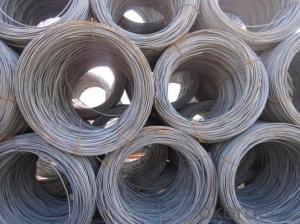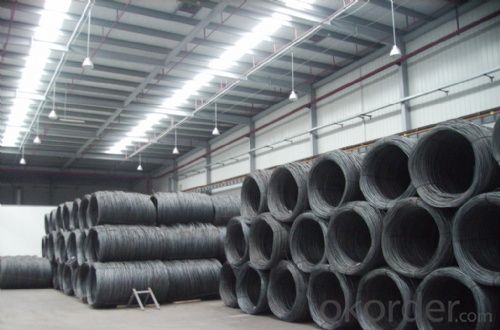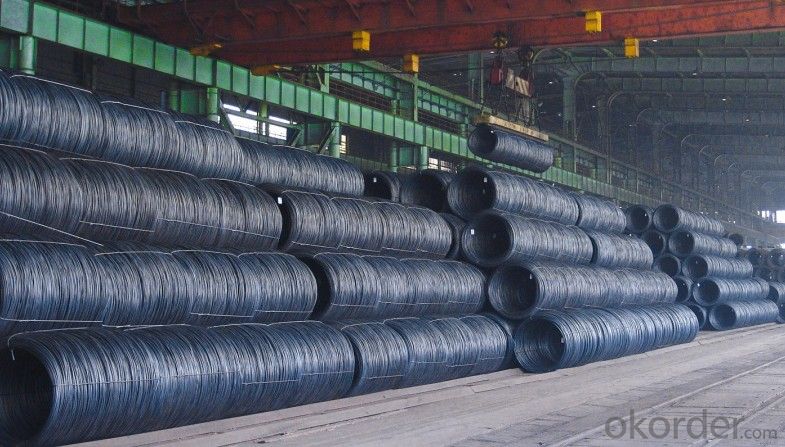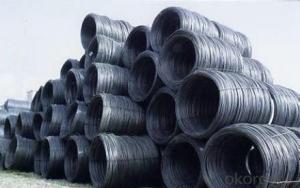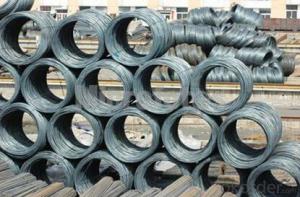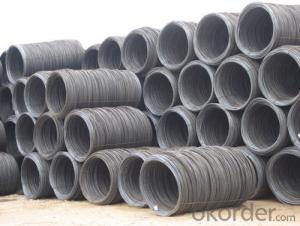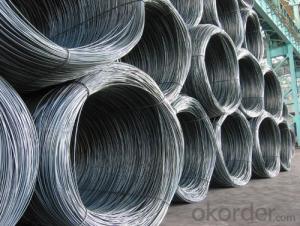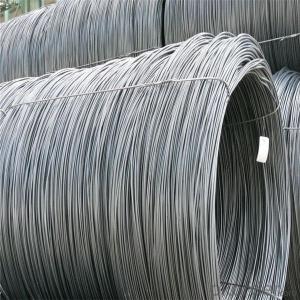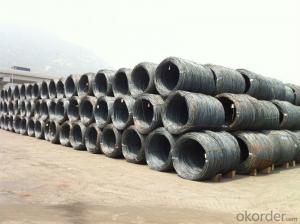GB Standard Steel Wire Rod with High Quality 9mm-10mm
- Loading Port:
- China Main Port
- Payment Terms:
- TT or LC
- Min Order Qty:
- 40 m.t
- Supply Capability:
- 15000 m.t/month
OKorder Service Pledge
OKorder Financial Service
You Might Also Like
Product Description:
Specifications of GB Standard Steel Wire Rod with High Quality 9mm-10mm:
Steel Grade: Q195 Standard:GB
Diameter: 9mm, 10mm
6.5mm can be drawing into 2mm/8.0mm can be drawing into 3mm
Each coil weight about 2MT
Chemical Composition:
Please kindly find our chemistry of our material based on Q195 as below for your information
Trademark | Rank | Chemical composition (quality score) % | |||||
C | Si | Mn | S | P | |||
| ≤ |
| ≤ | ≤ | |||
Q195 |
| 0.06-0.12 | 0.30 | 0.25 | 0.050 | 0.045 | |
Trademark | Rank | Pulling Test | |||||
Bend PointΔs/Mpa | Tensile Strength | Elongation Ratioδ5% | |||||
Thickness (Diameter) /MM | Thickness (Diameter) /MM | ||||||
≤16 | 16-40 | ≤16 | 16-40 | ||||
≥ | ≥ | ||||||
Q195 |
| 195 | 185 | 315-390 | 33 | 32 | |
Usage and Applications of GB Standard Steel Wire Rod with High Quality 9mm-10mm:
After hot-rolled the products shaped into coil and delivery as finished product, including round, square, rectangular, hexagonal and so on. Since most of the products are round, it is generally called wire rod. Carbon steel wire rod is widely used in construction and manufacturing. Carbon steel wire rod is mainly used for reinforcement of reinforced concrete and welded structure or reprocessed (roberts , nail, etc.) materials, especially used to produce wire drawing, welding electrode, nails, spring, electronic, precise machinery parts and so on.
Production Process of GB Standard Steel Wire Rod with High Quality 9mm-10mm:
Steel billet---Heating---Rolling---Water-cooling---Coiling---Cooling---Inspection---Bundling---Exworks
Packaging & Delivery of GB Standard Steel Wire Rod with High Quality 9mm-10mm:
Packaging Detail: products are packed in coil and then shipped by container or bulk vessel
Each coil weight: About 2MT
Delivery Detail: within 45 days after received deposit or original LC.
Label: to be specified by customer, generally, each bundle has 1-2 labels
Trade terms: FOB, CFR, CIF
FAQ:
Q1: How soon can we receive the product after purchasement?
A1: Within three days of placing an order, we will begin production. The specific shipping date is dependent upon international and government factors, but is typically one month.
Q2: How do you guarantee the quality of our products?
A2: We have established an advanced quality management system which conducts strict quality tests at every step, from raw materials to the final product. At the same time, we provide extensive follow-up service assurances as required.
Q3: The prices are invoicing on theoritical weight or on actual weight?
A3: We can do it in both manners, according to the customers' request.
Image of GB Standard Steel Wire Rod with High Quality 9mm-10mm
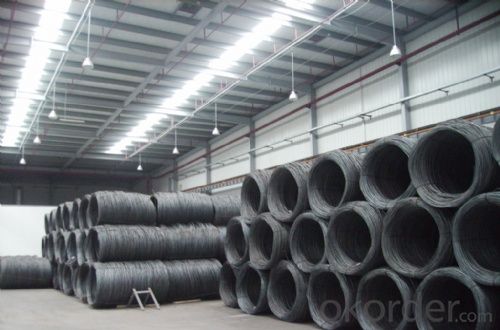
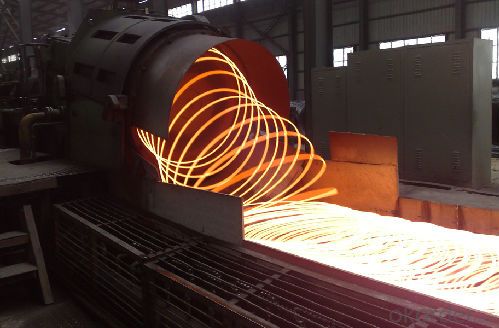
*If you would like to get our price, please kindlly inform us the size, standard/material and quantity. Thank you very much for your attention.
- Q: How is steel wire rod used in the manufacturing of wire for musical instrument strings?
- Steel wire rod is an essential component in the manufacturing of wire for musical instrument strings. It serves as the raw material that undergoes a series of processes to transform it into the high-quality wire used in guitar, piano, violin, and other instrument strings. To begin with, steel wire rod is typically made from carbon steel, which is known for its strength and durability. This makes it an ideal material for producing wire that can withstand the tension and stress exerted on musical instrument strings during playing. The manufacturing process starts with the steel wire rod being heated and then rolled into thinner strands through a process called drawing. This drawing process helps to refine the steel wire rod by elongating and thinning it, resulting in a more uniform and consistent diameter. Once the wire has been drawn to the desired thickness, it undergoes a series of heat treatments to improve its mechanical properties. This includes processes such as annealing, which helps to relieve stress and enhance the wire's flexibility and elasticity. After the heat treatments, the steel wire is further processed to achieve the desired characteristics for musical instrument strings. This can involve additional drawing steps to achieve the desired gauge or diameter, as different instruments require specific string thicknesses for optimal sound production. Furthermore, the wire can be coated with various materials to enhance its performance and longevity. For instance, a thin layer of nickel or stainless steel may be applied to improve corrosion resistance and provide a smoother surface for playing. Finally, the wire is wound onto spools, ready to be used by manufacturers of musical instrument strings. These strings are then carefully crafted and assembled, incorporating the steel wire as the core material that carries the tension and produces the desired pitch and tone when played. In summary, steel wire rod is a critical material used in the manufacturing of wire for musical instrument strings. Through various processes such as drawing, heat treatments, and coating, the steel wire rod is transformed into high-quality wire that meets the specific requirements of different instruments. The resulting strings provide musicians with the necessary strength, flexibility, and tonal characteristics to create beautiful music.
- Q: What are the main competitors of steel wire rod?
- The main competitors of steel wire rod include aluminum wire rod, copper wire rod, and other non-ferrous metal wire rods. Additionally, synthetic materials like fiberglass and carbon fiber also pose competition in certain industries where lightweight and high-strength alternatives are preferred.
- Q: What are the standard tolerances for steel wire rod diameter?
- The steel wire rod diameter's standard tolerances may vary depending on the specific industry and application requirements. However, the steel wire manufacturing industry commonly utilizes generally accepted tolerances. Typically, the standard tolerances for steel wire rod diameter range from +/- 0.002 inches to +/- 0.010 inches. These tolerances guarantee that the wire rod's diameter falls within a specific range, accommodating variations in the manufacturing process while still meeting the required specifications. Various factors, such as the wire's intended use, the manufacturing process employed, and the industry standards, can influence the specific tolerance range. For instance, wire rods used in high precision applications like medical devices or aerospace components may demand stricter tolerances to ensure accuracy and reliability. It is crucial to recognize that these standard tolerances can change based on the customer or industry's specific requirements. Manufacturers often collaborate closely with customers to determine the appropriate tolerances for their particular applications, considering factors like the desired level of precision, the wire rod's material properties, and any regulatory or industry standards that must be met. Overall, the standard tolerances for steel wire rod diameter serve as a guideline to ensure the wire rods' dimensional accuracy and consistency while allowing for reasonable variations during the manufacturing process.
- Q: What are the main properties of steel wire rod?
- The main properties of steel wire rod include high tensile strength, excellent ductility, good corrosion resistance, and high thermal conductivity. It is also known for its versatility and ability to be easily formed and shaped into various products. Additionally, steel wire rod has a high melting point and is highly resistant to wear and tear, making it ideal for applications that require durability and strength.
- Q: How does the thermal conductivity of steel wire rod vary with different grades?
- The thermal conductivity of steel wire rod typically varies with different grades. Higher-grade steel wire rod tends to have a higher thermal conductivity compared to lower-grade steel wire rod. This is because higher-grade steel wire rod is usually made with superior quality materials and has a more refined structure, allowing for better heat transfer. However, it is important to note that the exact variation in thermal conductivity can depend on various factors such as alloy composition, heat treatment, and processing techniques used during the manufacturing process.
- Q: How is steel wire rod used in the production of nails and fasteners?
- Nails and fasteners heavily rely on steel wire rod, a fundamental element in their manufacturing process. Serving as the main raw material, it grants the necessary strength and durability to these items. To create nails and fasteners, steel wire rod undergoes a series of carefully planned procedures. Initially, it is heated and rolled into a coil shape, enhancing its ductility and reducing its thickness. This procedure, known as hot rolling, imparts the wire rod with the essential properties required for subsequent manipulation. Following hot rolling, the wire rod goes through cold drawing, where it is pulled through a set of dies to further decrease its diameter. This process not only improves the wire's surface finish but also enhances its mechanical properties, including tensile strength and hardness. Upon completion of cold drawing, the drawn wire is cut into specific lengths, depending on the desired size of nails or fasteners. These lengths are then fed into either a nail making machine or a fastener production line. In the case of nails, the wire is passed through a cutter that shapes the nail heads and points. Conversely, for fasteners, the wire is molded and formed into the desired product, such as screws, bolts, or rivets. The quality of the steel wire rod utilized in the production of nails and fasteners is of utmost importance for the performance of the end products. It must possess exceptional tensile strength, as nails and fasteners are subjected to significant stresses during use. Moreover, the wire rod needs to exhibit corrosion resistance, ensuring that the nails and fasteners can endure exposure to moisture and other environmental conditions without deterioration. All in all, steel wire rod assumes a crucial role in the production of nails and fasteners, providing the indispensable strength, durability, and corrosion resistance necessary for these essential commodities.
- Q: How is steel wire rod used in the manufacturing of wire for shopping carts?
- Steel wire rod is used in the manufacturing of wire for shopping carts as it serves as the primary raw material. It is first drawn into the desired thickness and then bent or welded to form the framework and structure of the cart. The strength and durability of steel wire rod make it an ideal choice for withstanding the weight and load-bearing requirements of shopping carts in various commercial settings.
- Q: What is the pricing structure of steel wire rod?
- The pricing structure of steel wire rod varies based on several factors such as the quality of the steel, market demand, production costs, and global economic conditions. It is typically determined by market forces and can fluctuate over time.
- Q: What are the different surface marking materials used for steel wire rod?
- There are several different surface marking materials that can be used for steel wire rod. These materials are applied to the surface of the wire rod to provide identification and traceability. Some of the commonly used surface marking materials include: 1. Paint: Paint is one of the most common surface marking materials used for steel wire rod. It is applied in the form of a coating and can be used to mark various information such as product identification, grade, and manufacturer's logo. Paint markings are typically durable and can withstand normal handling and transportation. 2. Ink: Ink is another commonly used surface marking material for steel wire rod. It is applied using a printing process and can be used to mark various information such as product specifications, lot numbers, and barcodes. Ink markings are generally resistant to abrasion and can provide high-contrast visibility. 3. Hot stamping: Hot stamping is a process in which a marking foil is applied to the surface of the steel wire rod using heat and pressure. This technique allows for the transfer of pre-printed information onto the surface of the wire rod. Hot stamping is often used to mark important information such as heat numbers, production dates, and customer-specific requirements. 4. Laser marking: Laser marking is a non-contact marking process that uses a laser beam to create permanent markings on the surface of the steel wire rod. It is a precise and versatile marking method that can be used to engrave various information such as logos, serial numbers, and part numbers. Laser markings are highly durable and resistant to fading, making them suitable for long-term identification. 5. Etching: Etching is a chemical process that involves the removal of a thin layer of material from the surface of the steel wire rod. It is commonly used to create indented markings that can be filled with paint or ink for increased visibility. Etched markings are resistant to abrasion and can provide a long-lasting identification solution. Overall, the choice of surface marking material for steel wire rod depends on factors such as the required durability, visibility, and specific application requirements. Each of these materials has its own advantages and can be tailored to meet the specific needs of the wire rod manufacturer and end-user.
- Q: How are steel wire rods used in the manufacturing of springs?
- Steel wire rods are an integral component in the manufacturing of springs. These rods, which are typically made from high-quality steel, are first subjected to various processes such as hot rolling, cold drawing, and heat treatment to enhance their strength and durability. Once the steel wire rods have been prepared, they are then further processed to create the desired shape and characteristics for different types of springs. This can be achieved through techniques like coiling, twisting, or bending the wire rods into specific forms. The steel wire rods serve as the primary material for springs due to their excellent mechanical properties, such as high tensile strength and flexibility. These qualities are crucial for springs as they need to resist deformation and provide the necessary force when compressed or stretched. Furthermore, the steel wire rods used in spring manufacturing undergo stringent quality control measures to ensure consistency and reliability in their performance. This involves conducting tests to evaluate the wire's mechanical properties, such as tensile strength, elasticity, and fatigue resistance. Overall, steel wire rods play a vital role in the manufacturing of springs by providing the necessary strength and versatility required for these essential components. Their ability to withstand various forces and maintain their shape over time makes them a reliable choice for a wide range of applications, including automotive, aerospace, and industrial sectors.
Send your message to us
GB Standard Steel Wire Rod with High Quality 9mm-10mm
- Loading Port:
- China Main Port
- Payment Terms:
- TT or LC
- Min Order Qty:
- 40 m.t
- Supply Capability:
- 15000 m.t/month
OKorder Service Pledge
OKorder Financial Service
Similar products
Hot products
Hot Searches
Related keywords
